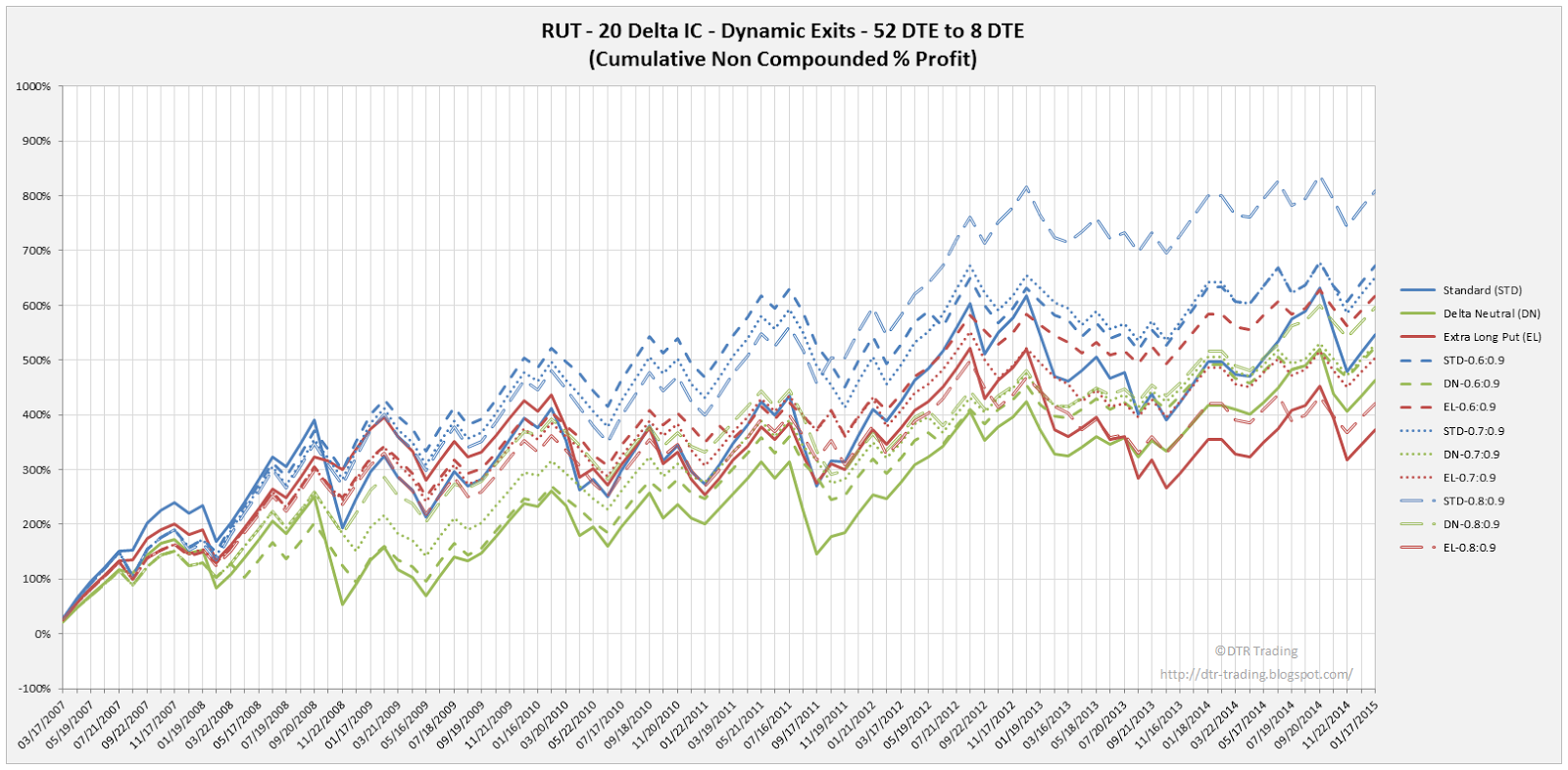For some background on how the results are presented and to read my prior dynamic exit posts, please visit the summary page: Dynamic Exit Iron Condor Articles.
As discussed in the two overview posts on the summary page above, we will look at the same three Iron Condor starting structures that have been backtested on this blog: Standard (STD), Delta Neutral (DN), and Extra Long Put (EL).
In this post we will only look at the Initial Credit % Profit/Loss Exit on each of the three starting structures:
- 0.6:0.9 - This is an Initial Credit % Profit/Loss Exit. Trades using this exit strategy either exit at 8 DTE OR if the trade has a profit of 90% of its initial credit OR if the trade has a loss of 60% of its initial credit. This can also be thought of as risk:reward; risking 60% to make 90%.
This equity curve chart below is similar to the equity curves in my prior posts. In the chart below, all of the STD Iron Condor versions have blue equity curves, all of the DN Iron Condor versions have green equity curves, and all of the EL Iron Condor versions have red equity curves. The solid lines represent the equity curves for the "no touch" version, while the dashed lines represent the equity curves for the dynamically exited versions.
 |
| (click to enlarge) |
The dynamic exit versions tested were closed at either 8 DTE or a profit of 90% of the initial credit received. The parameters that varied were the risk or loss amount. The trades were closed for a loss if the loss was either 60%, 70%, or 80% of the initial credit received. Three of the Standard Iron Condor options trading strategy (STD) versions outperformed all of the Delta Neutral (DN) and Extra Long Put (EL) versions. The thee top performers, in order, in terms of overall return were the STD-0.8:0.9, STD-0.6:0.9, and STD-0.7:0.9. STD-0.6:0.9 and STD-0.7:0.9 had fairly similar returns. The STD-0.9:0.9 version closed at either 8 DTE, a profit of 90% of the initial credit received, or a loss of 80% of the initial credit received.
The results by year, for each of the 52 DTE, 20 delta short Iron Condor options trading strategy versions are shown in the table below.
 |
| (click to enlarge) |
The details associated with each of the starting structure backtests can be found in the posts below:
- Standard Iron Condor - RUT - 52 DTE
- Delta Neutral Iron Condor - RUT - 52 DTE
- Extra Long Put Iron Condor - RUT - 52 DTE
In the next post I will summarize the dynamic exit results for the 52 DTE Iron Condor options trading strategies and show the associated trade statistics.
Also, if you came to my blog via TheWholeStreet.com, please note that their site has changed to Quantocracy (http://quantocracy.com)
If you don't want to miss my new blog posts, follow my blog either by email, RSS feed or by Twitter. All options are free, and are available on the top of the right hand navigation column under the headings "Subscribe To RSS Feed", "Follow By Email", and "Twitter". I follow blogs by RSS using Feedly, but any RSS reader will work.
2 comments:
0.6:0.9 - This is an Initial Credit % Profit/Loss Exit. Trades using this exit strategy either exit at 8 DTE OR if the trade has a profit of 90% of its initial credit OR if the trade has a loss of 60% of its initial credit. This can also be thought of as risk:reward; risking 60% to make 90%.
I think there's a typo in there. Don't you mean profit taking at 60% and loss exit at 90%?
Hi Michael,
Nope, there isn't a typo. Please take a look at the summary article for this series, where I describe each exit in detail: http://dtr-trading.blogspot.com/2015/05/which-iron-condor-options-strategy-is.html
Post a Comment